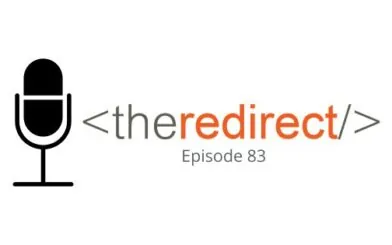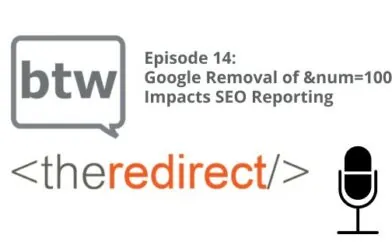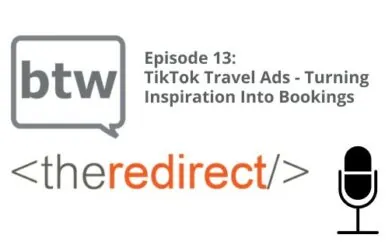In this episode of BTW w/ BTM we’re discussing Google’s shift away from third-party cookies on its popular Chrome browser. What some might mark as the end of an era in tracking online activities of users, and the start of a new complex chapter for digital marketing. As always, we’re unpacking the changes so you can be better prepared and a more informed marketer. Give it a listen below, or feel free to see the highlights in the show notes.
Google’s Initial Trial Run to Block Third-Party Cookies
Google has begun the trial run of its new Tracking Protection feature, signaling the end for third-party cookies in Chrome. We’re seeing the first glimpse of a cookieless future, affecting just one percent of Chrome users at this stage.
The Road to Phasing Out Third-Party Cookies
After several years and many adjustments, Google is moving forward with its plan. But it’s not a simple process. With regulatory scrutiny and the evaluation of Google’s alternatives to cookies being key steps in this journey and we’ll likely see conversations in the EU driving the outcome. The reason this is a potentially big deal is that given that Google’s Chrome browser is the leading browser with around 65% of market share the impact could be large, but very much unknown at this point too.
Chrome accounts for around 3.2 Billion users, so right now their test will impact 1% of that, or around 32 Million users.
How is the Industry Reacting to Google’s Privacy Sandbox?
The ad industry is cautious and wary about Google’s Privacy Sandbox. There’s a consensus on the uncertainties surrounding this initiative, especially regarding its impact on smaller publishers and the consolidation of power with large platforms.
It’s certainly a house divided over the Privacy Sandbox. Some see collaboration as strategic, while others are wary of reinforcing Google’s dominance in advertising. It’s a balancing act between innovation and maintaining relevance in the new ad world. We’ve written about this topic before, and when you start to break down the intricacies, given Google’s Privacy Sandbox and cohorts, it could hurt other platforms more than Google’s own.
What are the Alternatives to Third-Party Cookies
The alternatives to third-party cookies signal a transformative shift in online advertising. Yet, they come with their own set of challenges, including privacy compliance and targeting effectiveness. It’s a complex landscape that’s still taking shape.
Future Strategies for Marketers in a Cookieless World
Marketers are exploring various strategies in a post-cookie world, from authenticated IDs to contextual tactics. The goal is to navigate this new landscape effectively while adhering to privacy standards. But the key piece here is the privacy component that brands need to take into consideration. Just like mobile-first design as an approach to online user experiences in web development, we’re headed into the era of a privacy-first world. Meaning, the user is far more interested in what information brands have on them and where it is being used.
How Will Advertisers Adapt to Changes?
For advertisers, adapting to these changes is like learning a new language. If all you have ever known is English and you’re expected to live in Japan… eventually you have to speak the language, or try to. For awhile brands will have a blend of old strategies, evolving privacy laws, and new tech complexities. For some, it will be a significant shift in strategic thinking behind the efficacy of their digital advertising.
Taking Action in a Cookieless World
- Embrace First-Party Data – collecting and utilizing your customer data is and always has been your currency as a digital marketer.
- Explore New Technologies – where there is a mantra of wait and see, it doesn’t hurt to start looking at other emerging technologies as well and how you tie your data sources together.
- Prioritize Privacy Compliance – Ensuring your marketing strategies are compliant with privacy regulations based on where you do and intend to do business should be a priority anyways.
- Diversify Your Marketing Mix – As always, don’t rely solely on a single platform or technique. Diversify the channels and platforms you’re using and mitigate risks associated with any one source. Meaning, if this ends up benefiting Google and the use of contextual targeting inside the Google Display Network vs. your DSP provider, you might want to reconsider your ad efforts.
- Experiment with Contextual and Cohort-Based Advertising – Contextual targeting isn’t anything new.. And truthfully Cohort-based advertising isn’t either… but it’s becoming more prevalent as it places people into “buckets” vs direct targeting. More on this in a future episode and article.
- Leverage Data Partnerships – Publishers and content creators who have aggregate data will most likely become more popular.
- Prepare for a Multi-Solution Approach – There will not be a one-size-fits all approach. Based on the brand, based on the ad strategy and platform and who this impacts. Right now the biggest impact is to sites served outside of the Google ecosystem that rely on third-party cookie data to understand users.
There’s a lot yet to shake out of the trial run, with many eyes and ears focused on the outcome and scrutiny by the EU in the coming months. But for now, you have time.
Thank you for listening in to BTW w/BTM. If you found this episode valuable, please subscribe wherever you get your podcasts and check out past episodes and show notes in our blog. Until next time, good luck.




